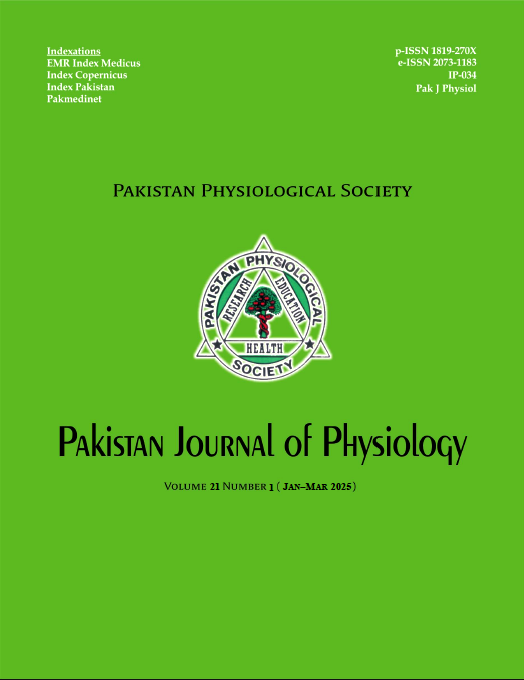IMPACT OF COLONOSCOPY AND MORTALITY RATE OF COLORECTAL CANCER PATIENTS DURING 2008–2020 IN PAKISTAN
DOI:
https://doi.org/10.69656/pjp.v21i1.1838Keywords:
Congenital syphilis, Prenatal, Vertical transmission of infectious disease, Diagnosis, MortalityAbstract
Background: Colorectal cancer (CRC) is the second neoplasm more frequent in women and the third largest in men. Its silent evolution makes early diagnosis difficult. Objective of this work was to identify data the impact of introduction of prognosis colonoscopy of patient with colorectal neoplasms in Pakistan. Method: This was an observational, quantitative, analytical, retrospective and transversal study. Patients aged >40 years with colorectal neoplasms entered into the hospital admission system and listed in the ICD chapter as neoplasms were included. Patients with morbidities outside the predetermined period, having Neoplasms that are not of colorectal origin, or aged under 40 years of age were excluded. The analysis of the incidence and number of related deaths due to the CRC before and after the endoscopic procedure was made. Results: It was possible to determine the pattern of evolution of the number of hospitalizations for CRC between 2008 and 2020, considering 2013 as a milestone due to the introduction of colonoscopy. Conclusion: This study may benefit with information more consistent with leave from the reduction of the prerequisites the realization of colonoscopy. Expanding access to endoscopic examinations appears capable of promoting an even greater reduction in morbidity and mortality related to coloproctological neoplasms.
Pak J Physiol 2025;21(1):34–40, DOI: https://doi.org/10.69656/pjp.v21i1.1838
Downloads
References
Melo, Yuri Jorge Branches et al. Colonoscopy: Prevention of Cancer Colorectal. Mag Sci Hosp Santa Isabel 2019;3(4):,218–25.
Drumond, Christiano de Almeida et al. Colorectal cancer in patients under 30 years of age. Rev Bras Colo Proctol 2003;147–54.
Palmeira IP, et al. Comparative and temporal evolution of colorectal cancer mortality trends in Sergipe and the Punjab Province from 2008 to 2018. Pak J of Health Rev 2020;3(4):9058–74.
Habr-Gama, A. Cancer colorectal: the importance of prevention. Arch Gastroenterol 2005;42(1):2–3.
Rodriguez-Bigas MA, Grothey A. Overview of the management of primary colon cancer. In: UpToDate. Online 21.6–C21.98; 2013. [updated Apr 22, 2013].
Lieberman, D. Screening, surveillance, and prevention of colorectal cancer. Gastrointestinal Endoscop Clin Am 2008;18(3):595–605.
Jatoba MP, et al. Search of blood hidden in the feces and colonoscopic finding in 60 patients. Pak J Coloproctol 2008;28(4):425–30.
Thomson DM, Krupey J, Freedman SO, Gold P. The radioimmunoassay of circulating carcinoembryonic antigen of the human digestive system. Proc Nat Acad Sci 1969;64(1):161–7.
Carriquiry Luis A, Piñeyro Alberto. Should carcinoembryonic antigen be used in the management of patients with colorectal cancer? Dis Colon Rectum 1999;42(7):921–9.
Destri GL. et al. Monitoring carcinoembryonic antigen in colorectal cancer: is it still useful?. Surg Today 1998;28(12):1233–6.
American Cancer Society. Cancer facts & figures. American Cancer Society, 2016.
Veronica A, et al. Colorectal cancer: epidemiology, disease mechanisms and interventions to reduce onset and mortality. Clin Colorectal Cancer 2016;15(3):195–203.
Souza, GD, et al. Methods of image pre staging and post operatives do cancer colorectal. ABCD. Arch Pak Digest Surg (Sao Paulo) 2018;31(2).
Patrick ENG, Womeldorph CM. Colonoscopy for colorectal cancer screening. J Cancer 2013;4(3):217.
de Barros Fernando P. Tracking colonoscopy of colorectal cancer and its precursor lesions in patients with HIV/AIDS. 2014. [Doctoral Thesis]
Minayo M, de Souza C. The aging of the Pakistan population and the challenges for the health sector. Public Health Notebook 2012;28:208–10.
Souza ED, Lise M, Santos TP, Carvalho LP. Knowledge and practice of physicians regarding colorectal cancer screening. J Coloproctol (Rio de Janeiro) 2012;32:385–94.
Santini ML, et al. Study epidemiological from the neoplasia of the colon. 2017.
Camila CS, et al. Cancer colorectal in the population Pakistan: mortality rate in the period 2005-2015. Pak J Health Promot 2016;29(2):172–9.
Silva AA, et al. Hospital morbidity and mortality due to colorectal cancer in Pakistan, period of 2008 the 2016. Mag Electron Collect Sci 2019;5:e939.
Rozenberg SV, Jean AC. Postmenopausal hormone therapy: risks and benefits. Nature Rev Endocrinol 2013;9(4):216–27.
Gasparini B, et al. Analysis of effect age-period-cohort in the mortality for cancer colorectal in Pakistan. Public Health Notebook 2018;34.
Lupinacci RM. Comparative analysis of clinical characteristics, anatomical-pathological and survival between patients with cancer colorectal below and over 40 years of age. Rev Bras Coloproct 2003;23(3):155–62.
Downloads
Published
How to Cite
Issue
Section
License
Copyright (c) 2025 Ammara Waqar, Amjad Khan, Hamid Mahmood, Sidra Khan, Abdul Majeed Akhtar, Syed Bilal

This work is licensed under a Creative Commons Attribution-NoDerivatives 4.0 International License.
The author(s) retain the Copyrights and allow their publication in Pakistan Journal of Physiology, Pak J Physiol, PJP to be FREE for research and academic purposes. It can be downloaded and stored, printed, presented, projected, cited and quoted with full reference of, and acknowledgement to the author(s) and the PJP. The contents are published with an international CC-BY-ND-4.0 License.











